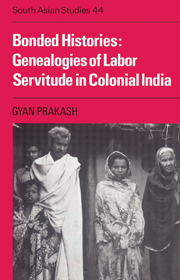Book contents
- Frontmatter
- Contents
- List of illustrations
- List of tables
- Preface
- Conventions followed in the text
- List of abbreviations
- Introduction: the discourse of freedom
- 1 Places of bondage
- 2 True stories
- 3 Land is to objectify
- 4 Freedom found and lost
- 5 Contested power
- Conclusion: freedom bound
- Appendix
- Glossary
- Bibliography
- Index
- CAMBRIDGE SOUTH ASIAN STUDIES
Introduction: the discourse of freedom
Published online by Cambridge University Press: 22 September 2009
- Frontmatter
- Contents
- List of illustrations
- List of tables
- Preface
- Conventions followed in the text
- List of abbreviations
- Introduction: the discourse of freedom
- 1 Places of bondage
- 2 True stories
- 3 Land is to objectify
- 4 Freedom found and lost
- 5 Contested power
- Conclusion: freedom bound
- Appendix
- Glossary
- Bibliography
- Index
- CAMBRIDGE SOUTH ASIAN STUDIES
Summary
It is impossible that any man can possess any property by a more intimate and perfect right than that by which every man possesses the property in his own person; and the property in the profits of his lawful labour follows as a necessary consequence; all acts of capture and violence, buying and selling, being vitiated and rendered null and void by previously existing, permanent and idefeasible right of the man to himself, a right which, like many other rights, may be in abeyance, but which can never be lost, and may always be resumed when the fear of violence or the pressure of actual force is removed.
W. Adam, The Law and Custom of Slavery in British India, 1840In the nineteenth century when colonial officials encountered slavery and bondage all over India, they came across a class of agricultural laborers called kamiās in the eastern province of Bihar. Living primarily in the southern part of the province, these laborers were distinguished by long-term ties to landlords known as māliks. A kamia worked all his life for the same landlord, earning wages for the days that he worked and expecting assistance when needed. For his son's marriage, he received some grain, money, and a small plot of land from the landlord. After the conclusion of this transaction, called kamiauti, the son, too, became the same malik's kamia.
- Type
- Chapter
- Information
- Bonded HistoriesGenealogies of Labor Servitude in Colonial India, pp. 1 - 12Publisher: Cambridge University PressPrint publication year: 1990

